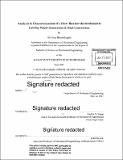Analysis & characterization of a flow thermo-electrochemical cell for power generation & heat convection
Author(s)
Booeshaghi, Ali Sina
DownloadFull printable version (5.808Mb)
Alternative title
Analysis and characterization of a flow thermo-electrochemical cell for power generation and heat convection
Other Contributors
Massachusetts Institute of Technology. Department of Mechanical Engineering.
Advisor
Evelyn N. Wang.
Terms of use
Metadata
Show full item recordAbstract
In this thesis, I analyzed and characterized a new flow thermo-electrochemical cell that generates power from waste-heat, while in parallel convecting this heat away from the source. I also reviewed previous research on the topic of thermo-electric energy generation, governing physics behind thermo-electrochemical energy generation, actual device fabrication, device testing, results, and applications of this technology. Thermo-electric devices (TE devices) exhibit the thermo-electric effect, where temperature gradients and material properties work in tandem to drive electron transfer at electrode surfaces, thereby generating electricity. For example, a typical sold-state TE device such as a bismuth telluride TE device, can generate up to 0.300 mV/K [31]. New reseach has emerged [25, 26, 14] focusing on liquid-based thermo-electrochemical (TEC) cells that take advantage of the temperature dependence of oxidation/reduction chemical reactions to generate electricity. One of the major benefits of these TEC devices over traditional TE devices is a much higher S, = 1.5 mV/K; another is the low cost of manufacturing, making them promising for commercial applications. The new TEC device that I fabricated and studied utilizes a flowing electrolyte instead of a stationary electrolyte. With this new configuration, and a heated boundary condition, I studied both the energy generation and convective heat transfer capabilities of the flowing electrolyte TEC cell. Numerically I obtained a maximum power output and heat transfer coefficient for the TEC cell of Pmax = 2.6 [mu]W and h = 340 W/m²K which corroborates well with the experimentally found value of Pmax = 2.0 [mu]W and h = 450 W/m². K. If employed in data centers, as a device for CPU cooling, with the given power output I found that a 100,000 ft² data center can generate about 21.96 MWh of energy, which at a cost of 0.20 $/kWh can save a data center about 5,000 $/year. More generally, the application of this technology in locations where waste-heat is prevalent, will allow for energy recycling and consequent cost savings.
Description
Thesis: S.B., Massachusetts Institute of Technology, Department of Mechanical Engineering, 2017. Cataloged from PDF version of thesis. Includes bibliographical references (pages 53-55).
Date issued
2017Department
Massachusetts Institute of Technology. Department of Mechanical EngineeringPublisher
Massachusetts Institute of Technology
Keywords
Mechanical Engineering.